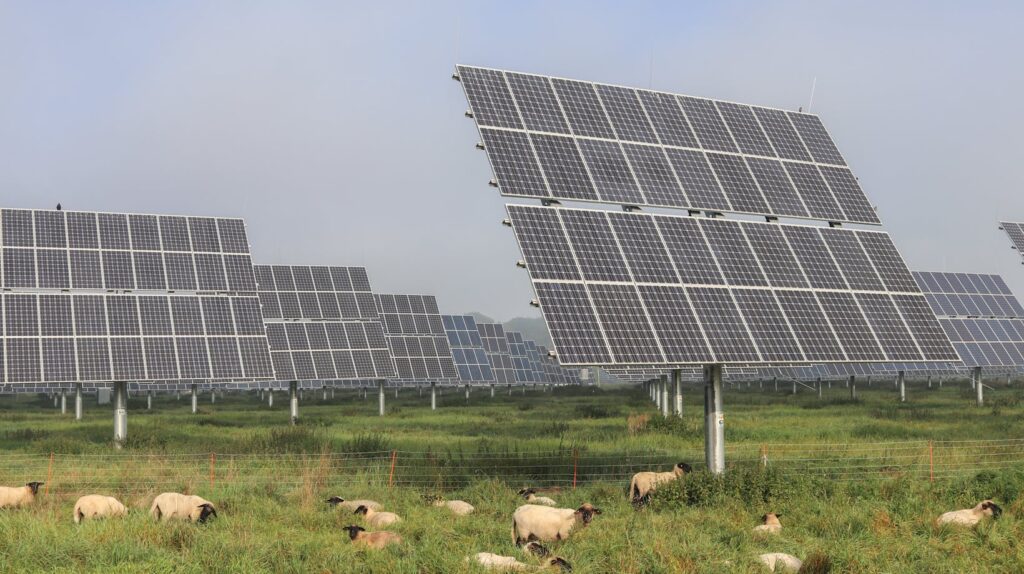When you think about solar farms, you might picture vast fields of panels soaking up the sun. But have you ever wondered just how much land these renewable energy sources actually require?
The land requirements for solar farms can vary significantly based on a multitude of factors. Understanding these influences is crucial for maximizing the efficiency and sustainability of these green energy projects.
So, let’s explore the intricate web of considerations that shape the land usage of solar farms and their implications for our environment.
Solar Farm Land Usage Overview
To understand the efficiency of solar farm land usage, examine the spatial distribution of solar panels. Land efficiency in solar farms is a crucial aspect to consider, especially in regions with strict zoning regulations. Zoning regulations dictate where solar farms can be located, impacting the amount of land available for solar panel installation.
By optimizing the layout of solar panels within these designated areas, solar farm developers can maximize the energy output per square meter of land.
Efficient land usage involves strategically placing solar panels to capture the most sunlight throughout the day. Factors such as shading from nearby structures or vegetation must be taken into account to ensure optimal energy generation. Additionally, zoning regulations may specify setbacks from property lines or height restrictions for solar panels, further influencing land usage efficiency.
Analyzing the spatial distribution of solar panels within the constraints of zoning regulations allows for the identification of opportunities to improve land efficiency. By adhering to these regulations while maximizing solar panel placement, solar farms can achieve higher energy yields from the available land area.
Factors Influencing Land Requirements
Efficient planning and design play a critical role in determining the land requirements for solar farms. When considering factors that influence land requirements, two key aspects come into play: land availability and regulatory constraints. Land availability is a crucial factor in determining the feasibility of establishing a solar farm. The size of the solar farm is directly impacted by the amount of land that can be dedicated to the project. Factors such as terrain, proximity to urban areas, and land use restrictions can all affect the availability of suitable land for solar development.
Regulatory constraints also play a significant role in determining the land requirements for solar farms. Zoning regulations, environmental considerations, and permitting processes can all impact the amount of land needed for a solar farm. Compliance with regulatory requirements is essential to ensure that the solar farm project meets legal standards and operates within the boundaries set forth by local authorities. By carefully considering land availability and regulatory constraints, developers can optimize the design and planning of solar farms to meet both energy production goals and regulatory requirements efficiently.
Calculating Solar Panel Acreage Needs
Land requirements for solar panel acreage can be accurately calculated by considering the energy output targets and panel efficiency ratios. Solar panel efficiency plays a crucial role in determining how much land is needed to meet a specific energy output goal. Higher efficiency panels can generate more electricity per square foot, reducing the overall land requirements for a solar farm. When planning a solar project, it’s essential to assess the available land availability and choose panels with optimal efficiency to maximize energy production within the given space.
In addition to solar panel efficiency, land availability is a key factor in calculating solar panel acreage needs. The amount of land accessible for the solar farm will directly impact the design and layout of the project. By considering both solar panel efficiency and land availability, developers can determine the required acreage accurately. This data-driven approach ensures that solar projects are designed efficiently, utilizing the available space effectively to meet energy production targets.
Environmental Impact Assessment Considerations
Considering the necessity for comprehensive evaluation in solar farm development, an essential aspect to address is the careful assessment of environmental impact considerations. Impact assessment is crucial to understand the potential effects of solar farm installations on the surrounding ecosystem. It involves evaluating factors such as land use changes, biodiversity impacts, soil quality alterations, and water resource usage. By conducting a thorough impact assessment, developers can minimize negative consequences and implement mitigation measures to protect the environment.
One key consideration in impact assessment is land conservation. Solar farms require significant land area, which can lead to habitat fragmentation and loss if not managed properly. Developers must assess the ecological value of the proposed site and consider measures to minimize disruption to local flora and fauna. Strategies such as implementing pollinator-friendly plantings, preserving buffer zones, and utilizing brownfield sites can help reduce the environmental footprint of solar farm projects. By integrating land conservation practices into impact assessments, solar developers can ensure sustainable land use and minimize adverse effects on the environment.
Sustainable Land Use Practices for Solar Farms
To enhance the sustainability of solar farm operations, implementing best practices for land utilization is crucial. Land conservation and efficiency are paramount in ensuring that solar farms are environmentally friendly. By strategically designing solar arrays and utilizing land effectively, the impact on the surrounding ecosystem can be minimized.
Integrating solar panels with agricultural activities, such as sheep grazing or pollinator-friendly plantings, can enhance biodiversity and habitat preservation in the area. These practices not only optimize land use but also contribute to the overall ecological health of the region.

Furthermore, employing techniques like agrovoltaics, which involve combining solar energy production with agricultural practices, can maximize land productivity while promoting sustainable land use. This dual-use approach not only reduces land competition between agriculture and solar energy but also supports local food production.
Conclusion
You’ve now grasped the intricate calculations and considerations behind solar farm land requirements. As you envision vast fields covered with panels, imagine the sun’s rays transforming them into powerhouses of energy.
The environmental impact assessments and sustainable land use practices are like the guiding stars in this green galaxy, ensuring a harmonious balance between technology and nature. Keep shining a light on the path towards a brighter, cleaner future.


